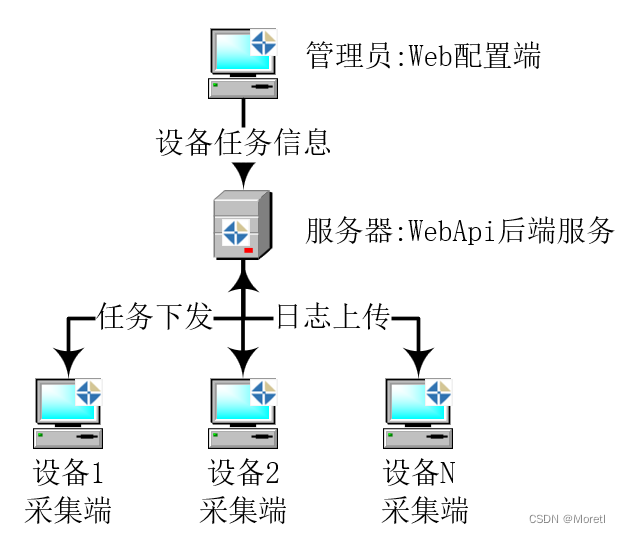如何书写伪代码:
ref:https://www.bilibili.com/video/BV12D4y1j7Zf/?vd_source=3f7ae4b9d3a2d84bf24ff25f3294d107
i=14时产出的图片比较合理
import json
import os.path
from matplotlib.ticker import FuncFormatter
import pandas as pd
import matplotlib.pyplot as plt# csv_path= r"/home/justin/Desktop/code/python_project/mypaper/data_process/CAM-01-SRV-lvm0.csv"
# df = pd.read_csv(csv_path, header=0, sep=",")
# df.head(5)
# df = df[["Timestamp", "Hostname", "DiskNumber", "Type", "LBA", "Size", "ResponseTime"]][df["Type"] == "Read"].reset_index(drop=True)
# base_dir = os.path.dirname(os.path.abspath(__file__))
# for i in range(1, 30):
# # 勾画出,数据的请求分布
# start_row = i * 100
# end_row = (i + 1) * 100
# print(start_row, end_row)
# df1 = df[['LBA']][start_row:end_row]
# from matplotlib.ticker import ScalarFormatter
# plt.plot(df1.index, df1.LBA)
# plt.title('Irregularity of I/O access locality')
# plt.xlabel('Access Order')
# plt.ylabel('Logical Block Address (unit:B)')
# def format_ticks(x, _):
# return f'{int(x):,}'
# plt.gca().yaxis.set_major_formatter(FuncFormatter(format_ticks),ScalarFormatter(useMathText=False))
# plt.gca().yaxis.get_major_formatter().set_scientific(False)
# plt.subplots_adjust(left=0.25)
# # plt.show()
# save_img_path = os.path.join(base_dir, 'weak_locality','irregularity_io_access_locality_{}.png'.format(i))
# print(save_img_path)
# plt.savefig(save_img_path, format='png')
# plt.clf()import os
import pandas as pd
import matplotlib.pyplot as plt
from matplotlib.ticker import FuncFormatter, MultipleLocator# Load the CSV file
csv_path = r"/home/justin/Desktop/code/python_project/mypaper/data_process/CAM-01-SRV-lvm0.csv"
df = pd.read_csv(csv_path, header=0, sep=",")
df.head(5)
pd.set_option('display.max_rows', None) # Show all rows
pd.set_option('display.max_columns', None) # Show all columns
pd.set_option('display.expand_frame_repr', False) # Prevent line wrapping for large DataFrames# Optionally, if you want to set width and precision for better formatting
pd.set_option('display.width', None) # Auto-detect the width of the display
pd.set_option('display.precision', 3) # Filter the DataFrame for 'Read' types and specific columns
df = df[["Timestamp", "Hostname", "DiskNumber", "Type", "LBA", "Size", "ResponseTime"]][df["Type"] == "Read"].reset_index(drop=True)
# Calculate the differences
df['LBA_diff'] = df['LBA'].diff()# Drop NaN values resulting from the difference computation
df = df.dropna(subset=['LBA_diff'])
LBA_diff_list = df['LBA_diff'].tolist()# def find_repeated_sequences(lst, length):
# """
# Find and return the first and last indices of the first repeating sequence of the given length.# :param lst: List of integers to search for repeating sequences.
# :param length: Length of the sequence to look for.
# :return: Tuple containing the first and last indices of the first repeating sequence, or None if not found.
# """
# sequence_indices = {}
# first_index = None
# last_index = None# # Iterate through the list to find sequences of the specified length
# for i in range(len(lst) - length + 1):
# # Get the current sequence as a tuple (to allow it to be a dictionary key)
# current_sequence = tuple(lst[i:i + length])# if current_sequence in sequence_indices:
# # If the sequence has been seen before, update indices
# first_index = sequence_indices[current_sequence][0] # First occurrence
# last_index = i # Update last occurrence
# break # Only need the first repeating sequence
# else:
# # Store the index of the first occurrence of this sequence
# sequence_indices[current_sequence] = (i,)# return (first_index, last_index)# # Example usage
# lst = LBA_diff_list[20000:]
# length = 5# result = find_repeated_sequences(lst, length)
# print(f"First occurrence: {result[0]}, Last occurrence: {result[1]}")
# print(df[20117:20123],df[20119:20125])
# # Exit the script if needed
# exit("==========")
# # Get the base directory path
# base_dir = os.path.dirname(os.path.abspath(__file__))# Get the base directory path
base_dir = os.path.dirname(os.path.abspath(__file__))for i in range(1, 30):if i!=14:continue# Define the start and end row indicesstart_row = i * 100end_row = (i + 1) * 100print(start_row, end_row)# Slice the necessary part of the DataFramedf1 = df[['LBA']][start_row:end_row].reset_index(drop=True)# Plot the dataplt.plot(df1.index, df1.LBA)plt.title('Irregularity of I/O Access Locality')plt.xlabel('Access Order (unit:times)')plt.ylabel('Logical Block Address (unit:B)')# Function to format y-ticks with commasdef format_ticks(x, _):return f'{int(x):,}'# Set the y-axis major formatterplt.gca().yaxis.set_major_formatter(FuncFormatter(format_ticks))# Set x-axis major and minor ticksplt.gca().xaxis.set_major_locator(MultipleLocator(10)) # Major ticks every 10 unitsplt.gca().xaxis.set_minor_locator(MultipleLocator(5)) # Minor ticks every 2 unitsax = plt.gca() # Get the current axesax.spines['top'].set_visible(False) # Hide the top spineax.spines['right'].set_visible(False) # Hide the right spineax.spines['left'].set_visible(True) # Show the left spineax.spines['bottom'].set_visible(True)# Adjust the margins if necessaryplt.subplots_adjust(left=0.25)# Constructing the save image pathsave_img_path = os.path.join(base_dir, 'weak_locality', 'irregularity_io_access_locality_{}.png'.format(i))print(save_img_path)# Save the plot as a PNG fileplt.savefig(save_img_path, format='png')# Clear the figure after savingplt.clf()# Plot the 'Size' columndf2 = df[['Size']][start_row:end_row].reset_index(drop=True) # Set the figure sizeplt.plot(df2['Size'], marker='o',markersize=2,linestyle='-',linewidth=0.5) # Plot with markersplt.title('Variablity of I/O Access Size')plt.xlabel('Access Order(unit:times)')plt.ylabel('Size(Unit:B)')plt.gca().xaxis.set_major_locator(MultipleLocator(10)) # Major ticks every 10 unitsplt.gca().xaxis.set_minor_locator(MultipleLocator(5)) # Minor ticks every 2 unitsax = plt.gca() # Get the current axesax.spines['top'].set_visible(False) # Hide the top spineax.spines['right'].set_visible(False) # Hide the right spineax.spines['left'].set_visible(True) # Show the left spineax.spines['bottom'].set_visible(True)# plt.grid() # Add grid for better readabilityplt.tight_layout() # Adjust layout to avoid clippingsave_img_path = os.path.join(base_dir, 'weak_locality', 'io_access_locality_size_{}.png'.format(i))plt.savefig(save_img_path, format='png')print(save_img_path)plt.clf()Total count: 246990497, Only once count: 52128003, ratio: 21.11%
Mean: 35004.78260010141
Median: 32768.0 中位数
Mode: 65536.0 众数
Minimum: 512.0 最小值
Maximum: 6410240.0 最大值
\documentclass{article}
\usepackage[ruled,longend,linesnumber]{algorithm2e}
\usepackage{xeCJK}\begin{document}
\begin{algorithm}
\KwIn{我在B站刷到了本视频}
\KwOut{我学会了,给个三连}
\Begin{
我在B站刷到了本视频\;
看标题好像有点用,点进去看看\;
\While{视频正在播放}{继续观看\;\tcc{不考虑没看懂某一部分,所以一直回看的死循环}\eIf{理解}{看下部分\;下部分变为这部分\;}{回看这部分\;}
}
我学会了,给个三连!
}
\caption{如何生成好看的伪代码}
\end{algorithm}\end{document}\documentclass{article}
\usepackage[ruled, longend, linesnumbered]{algorithm2e}
\usepackage{xeCJK}\begin{document}\begin{algorithm}
\KwIn{ $T$: LBA Sequence; \ $L$: Window size;}
\KwOut{$X$, $y$}
\tcc{X是列表,每个item包含(Delta-LBA,SIZE)两个元素数据\;y是列表,每个item包含(Delta-LBA,SIZE)两个元素数据\; L是滑动窗口大小}
\Begin{$i \gets 0$ \; $j \gets 0$ \; \While{$i + L < T.length()$}{$X[j] \gets T[i:i+L-1]$\;$y[j] \gets T[i+L]$\;$i \gets i+k$\;$j \gets j+1$\;}\KwRet{$X$, $y$}
}
\caption{LBA Feature Preprocessor}
\end{algorithm}\end{document}




